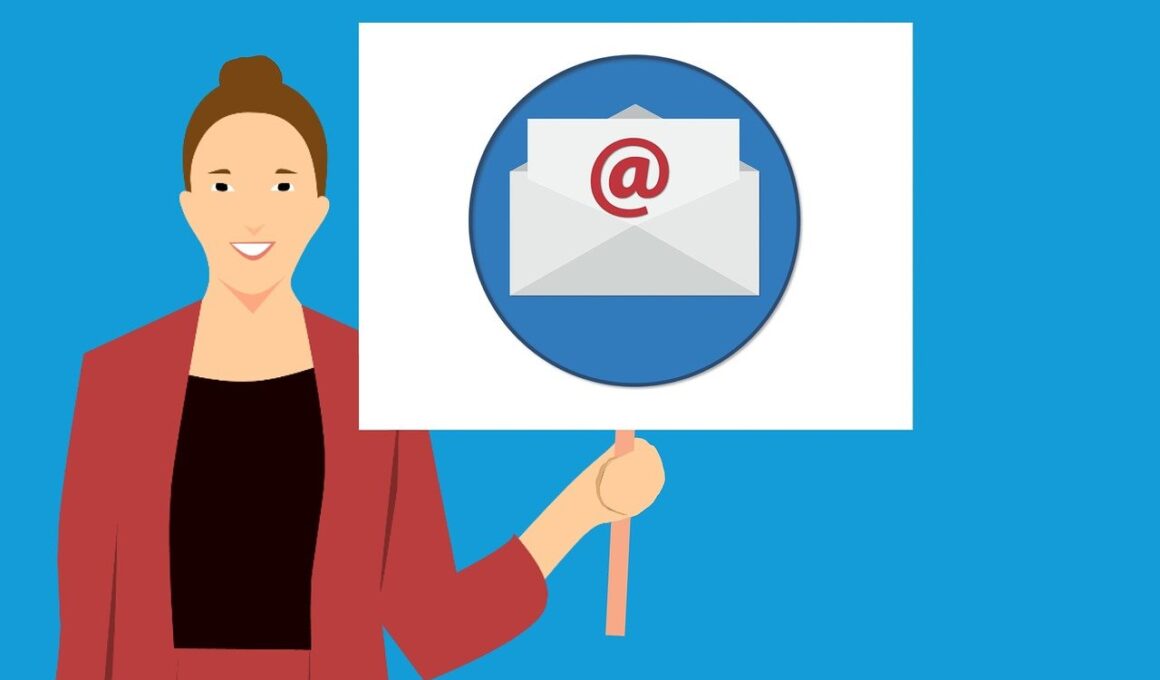How to Craft Effective Email Campaigns for B2B Financial Content Marketing
Email marketing is a crucial component of content marketing strategies in the B2B financial sector. Through careful planning and execution, financial institutions can engage their target audience effectively. This approach fosters a deeper relationship with potential clients while demonstrating expertise. Tailoring content to meet the unique needs of businesses is vital. Start by segmenting your email list based on industry, company size, or specific pain points. This allows for personalized messaging that resonates with recipients. Moreover, focus on delivering value through educational content, such as whitepapers, case studies, and insightful articles. Creating visually appealing emails is essential as well. Utilize a clean design that aligns with your brand and includes compelling images. Additionally, clear and persuasive call-to-action (CTA) buttons encourage readers to engage further. Tracking metrics, such as open rates and click-through rates, provides insights into campaign performance. Use this data to refine future campaigns, ensuring continuous improvement. Ultimately, the goal is to nurture leads effectively and convert them into loyal clients. By implementing these strategies, B2B financial marketers can significantly enhance their email campaign effectiveness and achieve better results.
Understanding your audience is the cornerstone of successful email marketing. In the B2B financial landscape, decision-makers are often inundated with information. Consequently, creating content that captures their attention is paramount. Begin by conducting thorough market research to identify trends and challenges faced by your target audience. Utilize surveys, interviews, or feedback from previous interactions to gain insights. The knowledge gained from this research should guide your content strategy. Develop emails that address specific pain points, offering solutions that highlight your organization’s strengths. For example, if clients struggle with regulatory compliance, share articles or resources that provide valuable guidance. Emphasizing your expertise in these areas fosters trust and positions your institution as a go-to resource. Always remember to maintain a professional tone while also being approachable. This balance is crucial in building rapport with stakeholders. Furthermore, testing different subject lines can lead to higher open rates. A/B testing allows you to determine which phrases resonate most with your audience, enhancing engagement. Ultimately, the foundation of a successful email campaign lies in knowing your clients and addressing their concerns directly.
Crafting Compelling Subject Lines
Crafting compelling subject lines is essential for improving email open rates in B2B financial content marketing. The subject line often serves as the first impression, making it crucial to capture the recipient’s interest immediately. Aim for clarity and brevity, keeping the subject line under 50 characters whenever possible. Personalization can also enhance the effectiveness of subject lines. Incorporate the recipient’s name or company to create an immediate connection. For instance, a subject line that says “[Recipient’s Name], Insights for [Their Company]” can draw attention. Moreover, employing urgency can compel recipients to open the email promptly. Words like “limited time” or “last chance” can create a sense of necessity. On the other hand, avoiding clickbait is equally important. Ensure that the content within the email aligns with what is promised in the subject line to maintain credibility. Testing various subject lines also provides valuable insight into what works best for your audience. Over time, studying engagement metrics will help refine your approach. Consequently, carefully selected subject lines can lead to higher engagement and success rates for email campaigns.
The body of your email content is where you convey essential information and value to your recipients. Keeping your content concise yet informative is vital, especially in the financial sector, where clients prefer straightforward communication. Start with a strong opening that clearly states the purpose of the email. Following this, break the content into easily digestible sections using bullet points or numbered lists. This approach enhances readability and allows busy professionals to grasp crucial information quickly. Highlighting key takeaways with bold text can also guide the reader’s attention to vital parts of your message. Furthermore, integrating visuals, such as infographics or charts, can effectively communicate complex data and insights, making the email more engaging. Don’t forget to include links to valuable resources, such as articles or case studies, that can provide deeper insights. Each email should also contain a clear call to action (CTA) that directs recipients towards the next steps, whether it’s signing up for a webinar or downloading a report. By focusing on a structured approach, you can boost recipient engagement and re-engagement rates.
Testing and Optimizing Campaigns
Testing and optimizing your email campaigns is crucial for improving performance over time. Start by utilizing A/B testing to experiment with different elements of your emails, including subject lines, send times, and content layout. This method allows you to compare the effectiveness of two versions and identify what works best for your target audience. Analyze key metrics such as open rates, click-through rates, and conversion rates to gather insights. For example, if you notice higher engagement with certain subject lines or content types, adjust your strategy accordingly. Additionally, tracking unsubscribe rates can provide insight into what may not resonate with recipients. Always take these metrics into account to refine future communications continually. Moreover, don’t hesitate to gather feedback directly from your audience through surveys or polls. Ask for input regarding their preferences related to email frequency and content topics. This feedback is invaluable as it allows for more tailored content that truly resonates. By prioritizing testing and optimization, B2B marketers can cultivate more effective email campaigns that yield better results.
Moreover, understanding the importance of timing is essential in B2B email campaigns. Timing can significantly affect the success of your email outreach. Generally, weekdays during business hours tend to yield better open rates compared to weekends or after-hours sends. However, it’s vital to consider your specific audience’s habits and preferences. Analyzing past campaign performance can uncover optimal sending times tailored to your specific market. Additionally, batch sending emails based on time zones ensures the content arrives when intended recipients are active. This strategy enhances the likelihood of immediate engagement. Furthermore, consider seasonal trends that may affect when your audience is more receptive to certain types of content. For example, during major financial reporting seasons, sharing relevant insights and resources can greatly resonate with recipients. Moreover, always review and adapt your strategies based on ongoing industry developments and company focus. Flexibility in your approach allows your marketing efforts to remain relevant and effective. By paying attention to timing, you can maximize the impact of your email campaigns and drive more conversions from your outreach.
Leveraging Analytics for Continued Improvement
Leveraging analytics is critical for the continued improvement of your email marketing campaigns in the B2B financial sector. By utilizing analytics tools, you can track various performance metrics and gain valuable insights into recipient behavior. Analyzing open rates provides insights into the effectiveness of your subject lines, while click-through rates reveal how engaging your content is. Paying attention to these metrics allows marketers to identify areas for enhancement quickly. Additionally, looking at conversion rates establishes how well your campaigns translate into actions that contribute to business goals. Regularly reviewing these metrics fosters an evidence-based approach to decision-making regarding email strategies. Furthermore, segmentation analytics can highlight which audience segments are performing better, guiding future targeting efforts. Adjusting your segmentation strategy accordingly can help in honing your messaging more precisely. Regularly updating your content based on current events or industry trends is also paramount. This responsiveness ensures your offers remain pertinent and attractive to your audience. Ultimately, leveraging analytics can lead to refined strategies that successfully convert leads and build stronger relationships with customers.
In conclusion, crafting effective email campaigns within B2B financial content marketing requires a holistic approach that prioritizes audience understanding, strong subject lines, impactful content, and ongoing optimization. By implementing these tried-and-true strategies, marketers can significantly enhance their email outreach. Remember that building relationships in B2B contexts takes time, effort, and a willingness to adapt based on feedback and performance metrics. Personalization, testing, and leveraging analytics create a foundation for long-term success. Always be prepared to iterate on your strategy as new challenges and opportunities arise in the ever-evolving financial landscape. By being proactive and mindful of your audience’s needs, you can create compelling campaigns that resonate deeply. Effective email marketing not only boosts your institution’s visibility but also helps foster lasting client relationships. These relationships can lead to increased trust, loyalty, and ultimately, conversions. With careful planning, execution, and analysis, your financial institution can maintain a competitive edge in the market. Above all, never underestimate the importance of clear communication and delivering value to your audience in every email.


